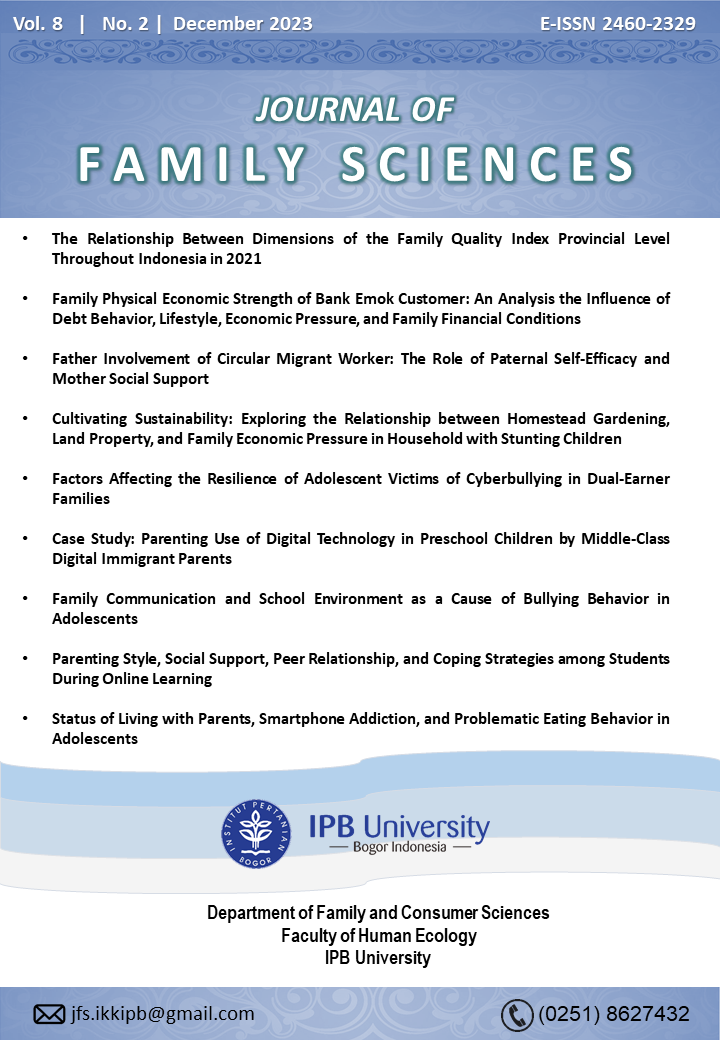Family Communication and School Environment as a Cause of Bullying Behavior in Adolescents
Abstract
Communication between adolescents and parents is an important part of the period of self-discovery. Bullying behavior that occurs in adolescents develops from an ongoing process of interaction in the family, school, and peer environment. Teens are especially vulnerable to engaging in bullying behavior. The communication environment of adolescents with parents, schools, and peers is an important factor in the occurrence of bullying behavior. Adolescents will imitate based on the results of observations encountered in family, school, and peers. Communication between adolescents and parents is important in minimizing bullying behavior. This research uses qualitative methods. Research location in Bogor. Data collection was conducted through observation, in-depth interviews, and documentation studies. The study involved five informants consisting of two bullies and three victims of bullying. The research informants selected were young men and women in Bogor, aged 17-18 years, high school students, and equivalent school who had been victims and/or perpetrators of bullying. In the initial stage, researchers distributed an open-ended questionnaire according to the above criteria. This open questionnaire aims to reveal aspects of the adolescent communication environment in the family, school environment, and peers. The results showed that the communication environment in the family, school, and peers of adolescents plays an important role in the occurrence of bullying behavior. Bullying behavior in adolescents begins as a victim and then as a perpetrator or perpetrator becomes a victim. Bullying carried out by adolescent girls at school is verbal and social, while bullying carried out by adolescent boys at school is verbal and physical.
Downloads
References
Azizah, S. A. N., & Hastuti, D. (2019). The influence of maternal acceptance-rejection and adolescents’ self-esteem on bullying behavior junior high school students. Journal of Family Sciences, 4(1), 12-25. https://doi.org/10.29244/jfs.4.1.12-25
Bandura, A. (2007). Social Foundation of Thought and Action, A Social Cognitive Theory. New Jersey (US): Prentice Hall
Unde, A., Bahfiarti, T., Pulubuhu, D. A. T., & Arsyad, M. (2020). Strategy on family communication and the extent of environmental health awareness in coastal areas. Enfermería Clínica, 30(1), 64-68. https://doi.org/10.1016/j.enfcli.2019.09.004
Bronfenbrenner, U. (2013). Ecology of the family as a context for human development: Research perspectives. Adolescents and Their Families, 1-20. https://doi.org/10.1037/0012-1649.22.6.723
Carney, A. G., & Merrell, K. W. (2001). Bullying in schools: Perspectives on understanding and preventing an international problem. School Psychology International, 22(3), 364–382. https://doi.org/10.1177/0143034301223011
Charalampous, K., Demetriou, C., Tricha, L., Ioannou, M., Georgiou, S., Nikiforou, M., & Stavrinides, P. (2018). The effect of parental style on bullying and cyberbullying behaviors and the mediating role of peer attachment relationship: longitudinal study. Journal of Adolescence, 64(1), 109-123. https://doi.org/10.1016/j.adolescence.2018.02.003
Cohen, J. L. (2010). Getting recognised: teachers negotiating professional identities as learners through talk. International Journal of Research and Studies, 26(1),473-481. https://doi.org/10.1016/j.tate.2009.06.005
Coloroso, B. (2006). Penindas, Tertindas, dan Penonton Resep Memutus Rantai Kekerasan Anak dari Prasekolah Hingga SMU. Jakarta (ID): Serambi.
Creswell, J. W., & Poth, C. N. (2016). Qualitative Inquiry and Research Design: Choosing among Five Approaches. New York (US): Sage Publications.
Feist, G. J. (2006). How development and personality influence scientific thought, interest, and achievement. Review of General Psychology, 10(2), 163-182. https://doi.org/10.1037/1089-2680.10.2.163
Fitriana, Y., Pratiwi, K., & Sutanto, A. V. (2015). Faktor-faktor yang berhubungan dengan perilaku orang tua dalam melakukan kekerasan verbal terhadap anak usia pra-sekolah. Jurnal Psikologi Undip, 14(1), 81-93. https://doi.org/10.14710/jpu.14.1.
Pramono, F., Lubis, D. P., Puspitawati, H., & Susanto, D. (2017). Communication pattern and family typology of high school adolescents in Bogor-West Java. Jurnal Komunikasi Ikatan Sarjana Komunikasi Indonesia, 2(1), 20-26. https://doi.org/10.25008/jkiski.v2i1.85
Gunawan, H. (2013). Jenis pola komunikasi orang tua dengan anak perokok aktif di Desa Jembayan Kecamatan Loa Kulu Kabupaten Kutai Kartanegara. Jurnal ilmu komunikasi, 1(3), 218-233.
Hennink, M., Hutter, I., & Bailey, A. (2020). Qualitative Research Methods. New York (US): Sage Publication.
Hinduja, S., & Patchin, J. W. (2008). Cyberbullying: An exploratory analysis of factors related to offending and victimization. Deviant Behavior, 29(1), 129-156. https://doi.org/10.1080/01639620701457816
Jessen, K. L. E. (2013). Depression in Adolescence: The Role of Emotional Stability and Parental Behavioral Control (master’s thesis).
Stattin, H., & Kerr, M. (2000). Parental monitoring: A reinterpretation. Child development, 71(4), 1072-1085.https://doi.org/10.1111/1467-8624.00210
Koerner, A. F., & Fitzpatrick, M. A. (2006). Family communication patterns theory: A social cognitive approach. Engaging theories in family communication: Multiple perspectives, 50-65. http://dx.doi.org/10.4135/9781452204420.n4
Kowalski, R. M., & Limber, S. P. (2007). Electronic bullying among middle school students. Journal of Adolescent Health, 41(6), S22-S30. https://doi.org/10.1016/j.jadohealth
Kusdiyati, S., Halimah, L., & Rianawati, R. (2010). Hubungan persepsi mengenai peran kelompok teman sebaya dengan “misdemeanors” di SMKN 8. MIMBAR: Jurnal Sosial dan Pembangunan, 26(2), 123-134. https://doi.org/10.29313/mimbar.v26i2.299
Lestari, A., Hasiholan, L. B., & Minarsih, M. M. (2016). Pengaruh sikap mandiri, lingkungan keluarga dan motivasi terhadap minat berwirausaha para remaja (studi empiris di Desa Jamus Kecamatan Mranggen Kabupaten Demak). Journal of Management, 2(2). Retrieved from https://jurnal.unpand.ac.id/index.php/MS/article/view/509/495
Malihah, Z., & Alfiasari, A. (2018). Perilaku cyberbullying pada remaja dan kaitannya dengan kontrol diri dan komunikasi orang tua. Jurnal Ilmu Keluarga & Konsumen, 11(2), 145-156. https://doi.org/10.24156/jikk.2018.11.2.145
Mefalopulos, P. (2008). Development Communication Sourcebook: Broadening The Boundaries of Communication. World Bank Publications.
Moral Jiménez, M. D. L. V., & Ovejero, A. (2021). Adolescents’ attitudes to bullying and its relationship to perceived family social climate [actitudes de los adolescentes hacia el bullying y su relación con el clima social familiar percibido.]. Psicothema.
Mulyatiningsih, E. (2011). Riset Terapan Bidang Pendidikan dan Teknik. Yogyakarta (ID): UNY Press.
Olweus, D. (2011). Bullying at school and later criminality: Findings from three Swedish community samples of males. Criminal Behaviour and Mental Health, 21(2), 151-156. https://doi.org/10.1002/cbm.806
Petrie, K. (2014). The relationship between school climate and student bullying. TEACH Journal of Christian Education, 8(1), 7.
Pongantung, H., Rosdewi, R., & Gamut, F. (2019). Penyuluhan Pencegahan Kekerasan Pada Anak. Celebes Abdimas: Jurnal Pengabdian Kepada Masyarakat, 1(1), 62-65. Retrieved from https://media.neliti.com/media/publications/385364-none-964ecf74.pdf
Priyatna, A. (2013). Let’s end bullying. Jakarta (ID): Elex Media Komputindo.
Ramadhanti, H. F., Simanjuntak, M., & Johan, I. R. (2022). The effect of work-family conflict, communication pattern, social support, and stress levels toward family quality of life during the COVID-19 pandemic. Journal of Family Sciences, 7(2), 119-135. https://doi.org/10.29244/jfs.v7i2.41937
Rohner, R. P. (1986). The Warmth Dimension: Foundations of Parental Acceptance-Rejection Theory. New York (US): Sage Publications, Inc.
Ryan, G. (2005). Preventing violence and trauma in the next generation. Journal of Interpersonal Violence, 20(1), 132-141. https://doi.org/10.1177/0886260504268605
Santrock, J. W. (2007). Perkembangan Remaja. Alih Bahasa: Shinto B. Adelar dan Sherly Saragih. Jakarta (ID): Erlangga
Smokowski, P. R., & Kopasz, K. H. (2005). Bullying in school: An overview of types, effects, family characteristics, and intervention strategies. Children & Schools, 27(2), 101-110. https://doi.org/10.1093/cs/27.2.101
Suparwi, S. (2014). Perilaku bullying siswa ditinjau dari persepsi pola asuh otoriter dan kemampuan berempati. INFERENSI: Jurnal Penelitian Sosial Keagamaan, 8(1), 159-179. https://doi.org/10.18326/infsl3.v8i1.159-179
Tsaousis, I. (2016). The relationship of self-esteem to bullying erpetration and peer victimization among schoolchildren and adolescents: A meta-analytic review. Aggression and Violent Behavior, 3(1),186-199. https://doi.org/10.1016/j.avb.2016.09.005
Zakiyah, E. Z., Humaedi, S., & Santoso, M. B. (2017). Faktor yang mempengaruhi remaja dalam melakukan bullying. Prosiding Penelitian Dan Pengabdian Kepada Masyarakat, 4(2). https://doi.org/10.24198/jppm.v4i2.14352
Authors who publish with this journal agree to the following terms:
- Authors retain copyright and grant the journal right of first publication with the work simultaneously licensed under

This work is licensed under a Creative Commons Attribution 4.0 International License. that allows others to share the work with an acknowledgement of the work's authorship and initial publication in this journal. - Authors are able to enter into separate, additional contractual arrangements for the non-exclusive distribution of the journal's published version of the work (e.g., post it to an institutional repository or publish it in a book), with an acknowledgement of its initial publication in this journal.
- Authors are permitted and encouraged to post their work online (e.g., in institutional repositories or on their website) prior to and during the submission process, as it can lead to productive exchanges, as well as earlier and greater citation of published work (See The Effect of Open Access).



_001.png)



